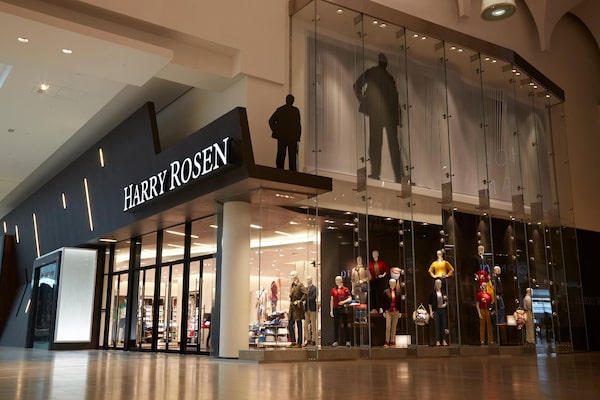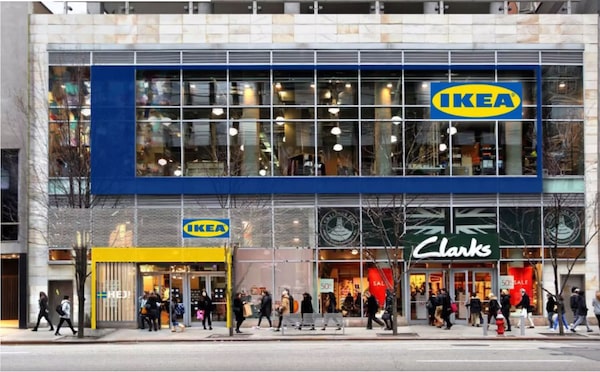
Retail sales in Canada have surpassed pre-COVID-19 levels after hitting historic lows during the height of the pandemic and customers return to brick-and-mortar locations.Tijana Martin/The Canadian Press
Retail sales in Canada have surpassed pre-COVID-19 levels after hitting historic lows during the height of the pandemic.
Total retail sales in July, the most recent month figures available, were 7.3 per cent higher than February, 2020, levels, according to Statistics Canada.
The agency’s report shows how consumer spending on various goods has shifted since the pandemic began. Spending on home improvement supplies, which soared by 24 per cent last year, declined for the fourth month in a row. With restaurants open, sales are also slightly lower for another pandemic top seller: groceries.
On the other hand, sales of clothing, one of the categories most affected by restrictions – sales plunged 29 per cent last year – have recovered to prepandemic levels, according to the report, released last month.
As consumers continued to return to the bricks-and-mortar locations, e-commerce sales fell by a hefty 19.5 per cent – marking the largest of four consecutive monthly declines.

Harry Rosen shop at Yorkdale Shopping Centre. Data analytics guide brand selections for target customers.Harry Rosen
But while online sales may be down 2.9 per cent relative to one year ago, they are still up by a whopping 67 per cent compared with prepandemic times.
Indeed, 82 per cent of Canadians shopped online in 2020, according to another Statscan report, released in June, spending $84.4-billion online – which accounted for 6 per cent of retail sales. (Canadian e-commerce trails many countries; in the United States, for example, e-commerce represents 16 per cent of total retail sales.)
The number of Canadian retailers offering an e-commerce platform doubled during the pandemic, according to a Colliers report, published in August.
Investors ploughed $3.6-billion into retail real estate in the first half of 2021, a total 20-per-cent higher than the (prepandemic) first half of 2019
— Managing director of national retail brokerage at Colliers in Vancouver
“Still, a lot of value remains in the bricks-and-mortar model – you just need to look at Alibaba and Amazon’s investment into the high street as evidence of that,” says Madeleine Nicholls, managing director of national retail brokerage at Colliers in Vancouver.
The value is also evidenced by CBRE’s latest report, which indicates investors ploughed $3.6-billion into retail real estate in the first half of 2021, a total 20 per cent higher than the (prepandemic) first half of 2019.
SMALLER STOREFRONTS
But the rise of e-commerce has retailers re-evaluating their retail footprint, Ms. Nicholls says.
Walmart Canada announced last November that more than one in four of its 403 Canadian locations will be renovated to make more space for e-commerce fulfillment.
Best Buy announced in February that its stores “will look different over time. We have started to evolve the way we use our stores for e-commerce fulfillment,” said Corie Barry, the company’s chief executive officer. In a number of locations, the electronics retailer has already reduced shoppable square footage by half.
Other large retailers are opening new, smaller stores closer to areas where customers live and shop. IKEA Canada expects to open its first smaller-format store in downtown Toronto in early 2022, the news release states.

IKEA in Manhattan. A similar small-format IKEA is set to open next year at Yonge and Gerrard streets in Toronto.IKEA/Handout
POST-OMNICHANNEL
The shift of consumer spending to the digital realm is driving the transformation of physical retail into an immersive, “phygital” experience, Ms. Nicholls says.
“Omnichannel has been a buzzword in retail for a long time,” says Ashley Barby, founder of Toronto-based, retail-innovators hub FashionTech, whose report, Store of the Future, was released this month.
As pandemic restrictions continue to ease, customers will expect “a post-omnichannel world – or a channel-less environment – where everything has merged, and the customer transacts seamlessly within all of them.
“I think that we’ll start seeing retail associates being leveraged as digitally equipped guides in this channel-less journey to provide a personalized but digital experience,” Ms. Barby says. “So, is that a physical purchase or an e-con purchase? I think the whole idea of one or the other – that’s going to change.”

Experience retailtainment at KitKat Chocolatory at Yorkdale Shopping Centre.Handout/Handout
EXPERIENTIAL
“Retail-tainment” is a concept that originated three decades ago, but now, more than ever, the retail landscape is moving towards showroom-style environments with cafés and events to engage shoppers, says Michael LeBlanc, senior advisor at Retail Council of Canada.
“Consumers have so much choice,” Mr. LeBlanc says. “You need to be remarkable. Shopping isn’t always just about a transaction. It’s cultural, social, getting inspiration.”
Mr. LeBlanc mentions several examples of “fabulous, brand-building retail-tainment,” from Nike’s basketball court with cameras to record shots, in New York, to Toronto’s KitKat Chocolatory, where customers create their own KitKat bar.
He’s particularly impressed, however, with a sector offering “some fantastically innovative” experiential shopping across Canada: cannabis stores.
Ontario purveyor Superette’s jubilant, candy-coated atmospherics, which won a 2020 Clio Award, “will blow your mind, just the design,” he says.
This summer, Superette reimagined the cannabis shop format once again with the launch of a first-of-its-kind “express” kiosk. The limited selection might best be enjoyed where the grab-and-go is located: across from Toronto’s Trinity-Bellwoods Park.

The basketball court at Nike’s flagship store in New York.Handout/Handout
ARTIFICIAL INTELLIGENCE
Transaction history collected at physical locations, combined with shoppers’ digital footprints, offer a “treasure trove of data,” Ms. Barby says. “It’s so powerful. Retailers can leverage it to build businesses.”
At Harry Rosen, data analytics, provided by Toronto-based Environics Analytics, revealed surprising insight about its youngest customer base: It often shops above lower-price-point products. Artificial intelligence also provided new insight about the menswear store’s core customers: They hit the company’s outlet stores more than expected.
Now, when Harry Rosen encounters a customer from one of its target segments, it can immediately identify brands that will have the greatest appeal, says Jay Sewell, director of analytics at Harry Rosen.
“One of the most transformational technologies, bar none, is going to be AI,” Mr. LeBlanc says. “With the predictive horsepower of AI, all kinds of data can tie together very eloquently. I could enter a Harry Rosen store. An associate would know immediately that I like Eaton shirts. ‘Hey, we have three new Eaton shirts, Michael, in your size, and we have them in stock. Would you like to see them?’
“I might not buy them, but that’s why I’ve come to the shop.”